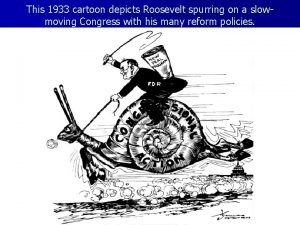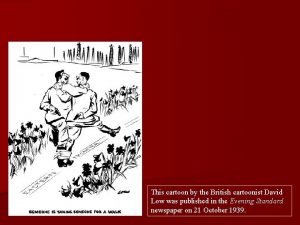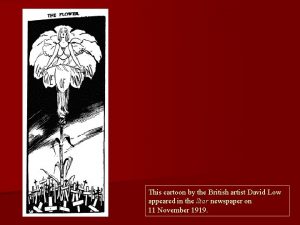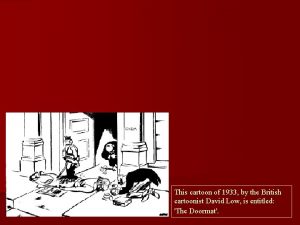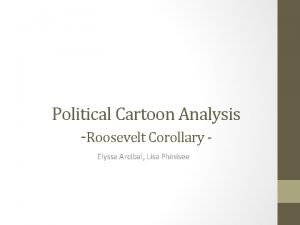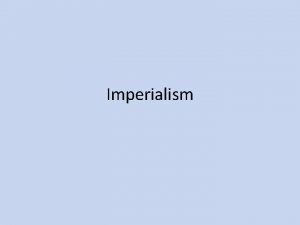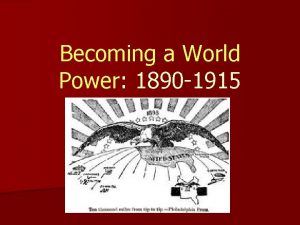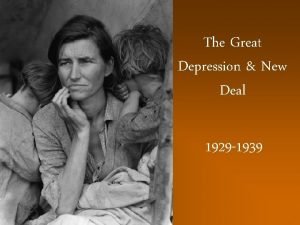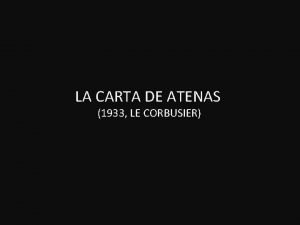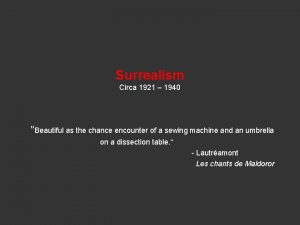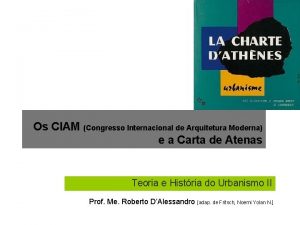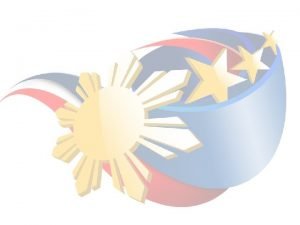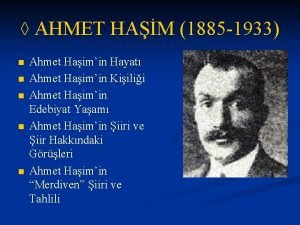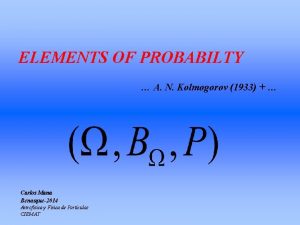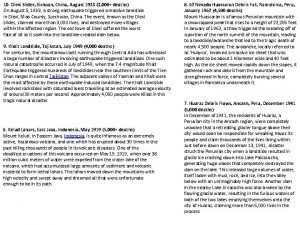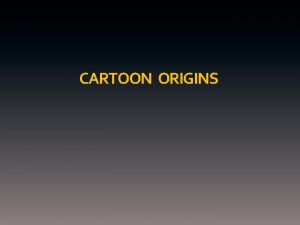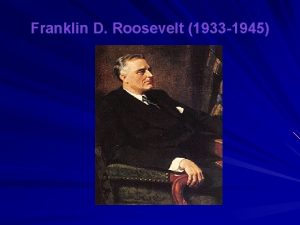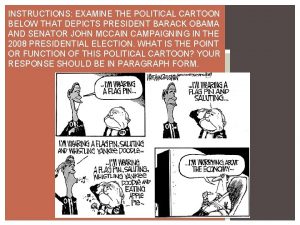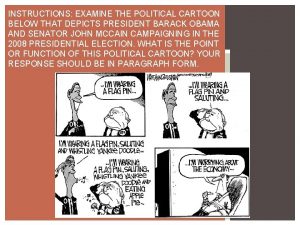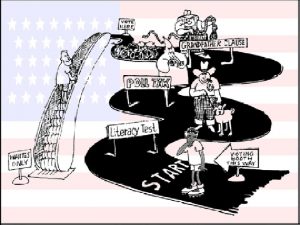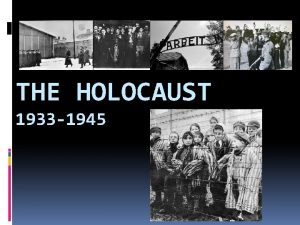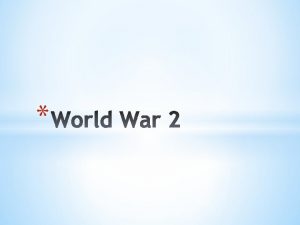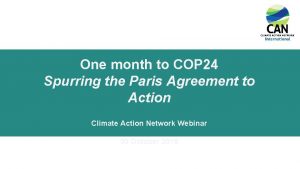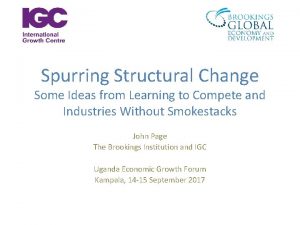This 1933 cartoon depicts Roosevelt spurring on a
















- Slides: 16

This 1933 cartoon depicts Roosevelt spurring on a slowmoving Congress with his many reform policies.

DO NOW n LOOK AT THE POLITICAL CARTOON BELOW. WHAT DOES IT SUGGEST ABOUT ROOSEVELT’S LEADERSHIP AND THE ROLE OF CONGRESS? EXPLAIN. LOOK AT THE TOP OF YOUR TEXTBOOK ON PAGE 519. NEW DEAL PROGRAM

Come Back Billions of Deficit Billions of Government Spending

1. What was the peak year of the deficit? 2. What relationships does there seem to be between deficit spending and unemployment?

DO NOW WHAT ARE SOME OF THE REASONS WHY PRESIDENT ROOSEVELT BEGAN CUTTING BACK ON HIS NEW DEAL PROGRAMS? WHY DIDI INDUSTRIAL PRODUCTION DROP AND UNEMPLOYMENT GO UP AGAIN IN 1938? n LOOK IN YOUR TEXTBOOK ON PAGES 515 -519 UNDER THE SECTION TITLED NEW DEAL REFORMS ENDURE n

Chapter 16 World War Looms

Section 1: Dictators Threaten World Peace n Less than two decades after the end of WWI—”the war to end all wars”— righting erupted again in Europe and in Asia. Americans read about distant battles, they hoped the conflicts would remain on the other side of the world. The seeds of new conflicts had been sown in World War I. For many nations, peace had brought not prosperity but revolution furled by economic depression and struggle. The postwar years also brought the rise of powerful dictators driven by the belief in nationalism—loyalty to one’s country above all else—and dreams of territorial expansion.

Germany experienced hyperinflation in 1923. The economic demand of reparation payments, required by the Treaty of Versailles was the prime cause of inflation. n How do you think the Germans felt about their government and the Treaty of Versailles during that time? n

Instead of securing a “just and secure peace, ” the Treaty of Versailles caused anger and resentment. Germans saw nothing fair in a treaty that blamed them for starting the war. Nor did they find security in a settlement that stripped them of their overseas colonies and border territories. These problems overwhelmed the Weimar Republic, the democratic government set up in Germany after World War I. Similarly, the Soviets resented the carving up of parts of Russia. The peace settlement had not fulfilled President Wilson’s hope of a world “safe for democracy. ” New democratic governments that emerged in Europe after the war floundered. Without a democratic tradition, people turned to authoritarian leaders to solve their economic and social problems. The new democracies collapsed, and dictators were able to seize power. Some had great ambitions. 1. post WWI n 2. Treaty of Versailles n n 3. democratic gov’t n 4. consequences n n 1. brought rise of dictators & belief in nationalism (love to one’s country) 2. treaty ending WWI caused anger and resentment for Germany & Russia 3. were falling in Europe 4. people turned to dictators (ruler w/total power) to solve economic and social problems


In Russia, hopes for democracy gave way to civil war, resulting in the establishment of a communist state, officially called the Soviet Union, in 1922. After V. I. Lenin died in 1924, Joseph Stalin, whose last name means “man of steel, ” took control of the country. Stalin focused on creating a model communist state. In so doing, he made both agriculture and industrial growth the prime economic goals of the Soviet Union. Stalin abolished all privately owned farms and replaced them with collectives—large government-owned farms, each worked by hundreds of families. Stalin moved to transform the Soviet Union from a backward rural nation into a great industrial power. In 1928, the Soviet dictator outlined the first of several “five -year plans, ” to direct the industrialization. All economic activity was placed under state management. 5. created a communist state in Russia; made both agriculture and industrial growth the main goals n 6. collectives n 6. abolished all privately owned farms and created gov. owned farms n 7. all was placed under state n 7. economic management activity n 5. Joseph Stalin n

Joseph Stalin Transforms the Soviet Union n By 1937, the Soviet Union had become the world’s second-largest industrial power, surpassed in overall production only by the United States. The human costs of this transformation, however, were enormous. In his drive to purge, or eliminate anyone who threatened his power, Stalin did not spare even his most faithful supporters. While the final toll will never be known, historians estimate that Stalin was responsible for the deaths of 8 million to 13 million people. Millions more died in famines caused by the restructuring of Soviet society.

In 1936, 1937, and on into 1938, Stalin eliminated challenges to his rule by attacking his closest allies and leaders of the revolution. The world watched the accused plead guilty to the state’s outlandish charges of treason and counter-revolution, knowing full well that such confession would result in their execution. The show trials made a big impact on American communists and sympathizers. Many saw the potential totalitarian underpinnings of Communism and deserted the movement.

By 1939, Stalin had firmly established a totalitarian government that tried to exert complete control over its citizens. In a totalitarian state, individuals have no rights, and the government suppresses all opposition. While Stalin was consolidating his power in the Soviet Union, Benito Mussolini was establishing a totalitarian regime in Italy, where unemployment and inflation produced bitter strikes, some of which were communist led. Alarmed by these threats, the middle and upper classes demanded stronger leadership. Mussolini took advantage of this situation. A powerful speaker, Mussolini knew how to appeal to Italy’s wounded national pride. He played on the fears of economic collapse and communism. In this way, he won the support of many discontented Italians. By 1921, Mussolini had established the Fascist Party. Fascism stressed nationalism and placed the interest of the state above those if individuals. To strengthen the nation, Fascists argued, power must rest with a single strong leader and a small group of devoted party members. (The Latin fasces—a bundle of rods tied around an ax handle—had been a symbol of unity and authority in ancient Rome. ) 8. totalitarian gov n n 9. Benito n Mussolini n n 10. Fascism n 8. individuals have no rights 9. developed Fascist party in Italy 10. power in the hands of a single leader and a small group of devoted party members

The Rise of Fascism in Italy n In October 1922, Mussolini marched on Rome with thousands of his followers, whose black uniforms gave them the name “Black Shirts. ” When important government officials, the army, and police sided with the Fascists, the Italian king appointed Mussolini head of government. Calling himself Il Duce, or “the leader, ” Mussolini gradually extended Fascist control to every aspect of Italian life. Tourists marveled that Il Duce had even “made the trains run on time. ” Mussolini achieved the efficiency, however, by crushing all opposition and by making Italy a totalitarian state.

 Cartoon 1933
Cartoon 1933 David low someone is taking someone for a walk
David low someone is taking someone for a walk A cartoon that appeared in a british newspaper in 1919
A cartoon that appeared in a british newspaper in 1919 Salute cartoon
Salute cartoon British cartoon by david low 1934
British cartoon by david low 1934 Roosevelt corollary
Roosevelt corollary Roosevelt corollary cartoon
Roosevelt corollary cartoon Roosevelt corollary
Roosevelt corollary National industrial recovery act of 1933
National industrial recovery act of 1933 Carta de atenas
Carta de atenas Man ray minotauro
Man ray minotauro Ciam 1933
Ciam 1933 Pagyakap sa modernisasyon ng mga kanluranin
Pagyakap sa modernisasyon ng mga kanluranin Merdiven şiiri tahlili
Merdiven şiiri tahlili Kolmogorov 1933
Kolmogorov 1933 Csci 1933 umn
Csci 1933 umn Diexi slides
Diexi slides
